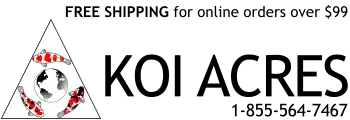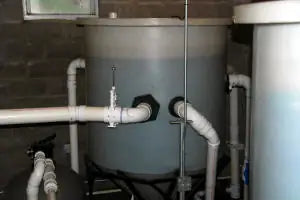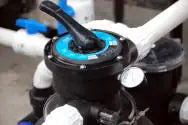Koi Pond Filters
How each filter component works to clean your pond
Bottom Drains
Bottom drains are installed at the bottom of the Koi pond, at the lowest level. They remove waste, which then travels to the filter system where it is captured by a large pump basket, filter chamber or vortex filter. If there is no bottom drain in a pond, waste will accumulate and will create toxic conditions for the Koi.
There are many sizes and types of bottom drains. The only bottom drains we use and install have a four inch diameter pipe connection. These are difficult to clog and get a very good flow rate.
Lately, bottom drains with built-in air diffusers have become popular. We manufacture our own, the KASS aerated bottom drain.
Attaching an air diffuser to a bottom drain accomplishes many things:
- the pond is aerated
- there is no airline in the pond
- the rising column of air makes the bottom drain work better (the current it generates help move debris into it)
 |
 |
Koi pond filters can clean ponds both large and small
Surface Skimmers
Skimmers remove light weight debris from the surface of the pond. They collect leaves, seeds, uneaten food and any other waste that floats on top of the water. Skimmer have a weir that stays just below the surface. It makes sure the skimmer draws water only from the from the very top at all times, it even adjusts for a changing water level.
A skimmer that's paired with a bottom drain keeps maintenance in the pond at an absolute minimum. The majority of the work is taken care of. You stay out of the pond, it stays clean automatically, there is no hauling muck out.
Vortex Chambers
Larger ponds (8,000+ gallons) should have a vortex chamber. They can collect a lot of leaves in the fall, it's too much work to clean a pump basket out many times a day. The vortex chamber is piped directly from the bottom drain. All the debris that the bottom drains pick up are deposited in the vortex chamber.
The centrifugal force of the spinning water forces the waste to the outer edge of the chamber, where it sinks to the bottom. The pump inlet is positioned in the very center of the chamber, facing upward. Any bottom drain feeds are angled towards the side to help with the current. There is a drain pipe with a valve at the bottom. When enough waste is accumulated, the valve is opened and the waste is flushed out.
Pump
The pump moves water, it is the heart of the filter system. Without a pump, a garden pond will be a stagnant pool of water.
There are two types of pumps that are used in water gardens, external and submersible. Submersible pumps sit in the water, usually in a skimmer. They are easily hidden, but use a ton of electricity.
External pumps sit outside and away from the pond, usually in a filter area. They are energy efficient and can handle a great deal of head pressure (from filter material resistance, piping and pushing water up hill to a waterfall.) External pumps last longer than submersibles. Submersible pumps usually seize up after a couple seasons of operation, while external pumps keep running year after year.
Unlike submersible pumps, which only draw water from a single source, external pumps can draw water from multiple sources. Our largest pump, the Sequence Titan, can pull water from three skimmers, a vortex chamber and then some.
We only use Sequence pumps, they are very quiet while running. A filter system should keep the pond clean while being as quiet as possible. They do an exceptional job at backwashing bead filters too.
Bead Filters
Koi fish are living animals, they are going to produce waste. That waste needs to be removed from the pond as fast as possible. Imagine being locked in a room with no toilet. It's going to get unpleasant very fast. That is what conditions are like in a pond with no filter. We use bead filters to take out the waste from our Koi ponds.
Bead filters handle three types of waste:
- fine, suspended particles like dirt and dust
- solid fish waste
- Ammonia that Koi excrete from their gills (it also leeches off of their waste)
They have a plastic media that clumps together when the system is running. Once you've collected the waste, it will need to be flushed from the filter. Other pond systems use pads to collect the fish waste. These pads need to be sprayed off with a hose. The fish waste usually ends up getting splattered everywhere. Bead filters have a backwash setting that agitates the media and cleans it automatically, like a pool filter. Backwashing the filter usually takes a few minutes a week, with a turn of a valve.
The media inside the filter provides an excellent home for nitrifying bacteria. Nitrifying bacteria take the Ammonia that Koi produce and converts it to a nearly harmless substance, Nitrate. Nitrate is then removed from the pond by a protein skimmer, water changes, or aquatic plants.
We use the Ultima II bead filters. The media never needs to be replaced, it is hard to clog and it requires only the pump to backwash (other filters require an air pump to help agitate the media.)
UV Sterilizers
The filters convert waste into fertilizer, which helps grow aquatic plants (especially algae.) Unfortunately, algae will turn the water in your pond green, which makes it difficult to view your Koi.
UV sterilizers are used to get rid of that green pond water. Water flows through the unit and is bathed in UV light. The UV light disrupts the DNA of the algae, so it can't reproduce. The bulb emits light at around 260nm, in the germicidal band.
A huge factor in how effective a UV sterilizer is the time it takes for water to pass through the unit. The longer it takes for water to pass through the sterilizer, the more UV light it will be exposed to. Many manufacturers will put their UV in a small body and overrate them by exaggerating their pond size that they can handle. We use the Emperor Aquatics UV lights because they have a wide chamber the bulb sit in, so the water flowing through it has plenty of dwell time.
Protein Skimmers
Protein skimmer are relatively new in the ponding industry. They remove the the finest particles of waste from the pond water, dissolved solids. Dissolved solids are microscopic in size. They are completely immersed in the water. Adding a protein skimmer to your filter system will greatly increase the health of your Koi.
Koi need a lot of fresh water to boost their growth rates. That is one of the reasons why they grow so fast in the mud ponds in Japan. Garden pond are just too overstocked and too small to have the conditions of a large body of water. A protein skimmer will make the water in the pond almost as clean as it was when it came out of the hose.
We use the Clarity protein skimmer, it has a simple design with no moving parts. It is also easily installed on nearly every pond system.
All of the filter system components work together to make the pond habitable for Koi. The filters we design are scale-able, almost any sized Koi pond can be filtered.









